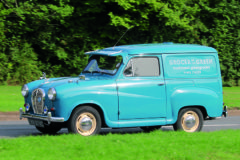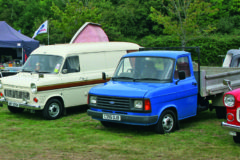Foden heavy-hauler
Posted by Chris Graham on 16th September 2020
If you think this much-travelled 1959 6×4 Foden heavy-hauler was been restored just to look good, then think again, as Bob Tuck explains.
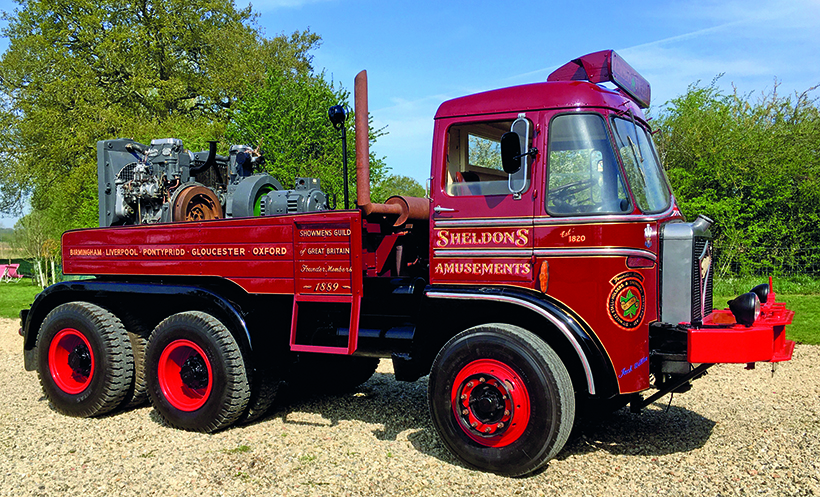
Foden heavy-hauler: It’s hard to believe this beautifully-restored Foden was written-off in 1967, after it caught fire on the M6 motorway.
Twenty-twenty is a year few of us will ever forget. At the time of writing, the country – and most of the world – is still coming to terms with how to survive the Covid-19 virus. There seems little joy either in the preservation scene which, like many others, is almost stuck in hibernation mode. So in that respect, we have Oxfordshire-based showman William Sheldon and his Foden heavy-hauler to thank for bringing a small ray of sunshine into our lives.
When I say ‘small’, that’s, of course, relative because 1959 heavy-haulers don’t come much bigger than ODB 793. No surprise perhaps this model FRHT 6/80 was given the affectionate nickname of ‘The Big Bopper’ when it first worked for the large Stockport concern of Edward Beck & Son Ltd.

One of the Sheldon family’s most treasured photographs is this one that was taken at the Great Neath Fair, in 1919. George Sheldon is seen almost in the centre of shot, wearing a dicky bow and waistcoat, and surrounded by fellow members of the SWSSPA. The almost-hidden Sheldon vehicle is an ex-military FWD, which was aptly named ‘Discharged Soldier’.
When it comes to pedigree, the tractor’s manufacturer of Foden can look back to 1856 when its founder first stepped into engineering. That’s certainly impressive although, if you talk want to compare time-lines, then none comes much more impressive than the Sheldon family – and its very close involvement with the showmans’ life.
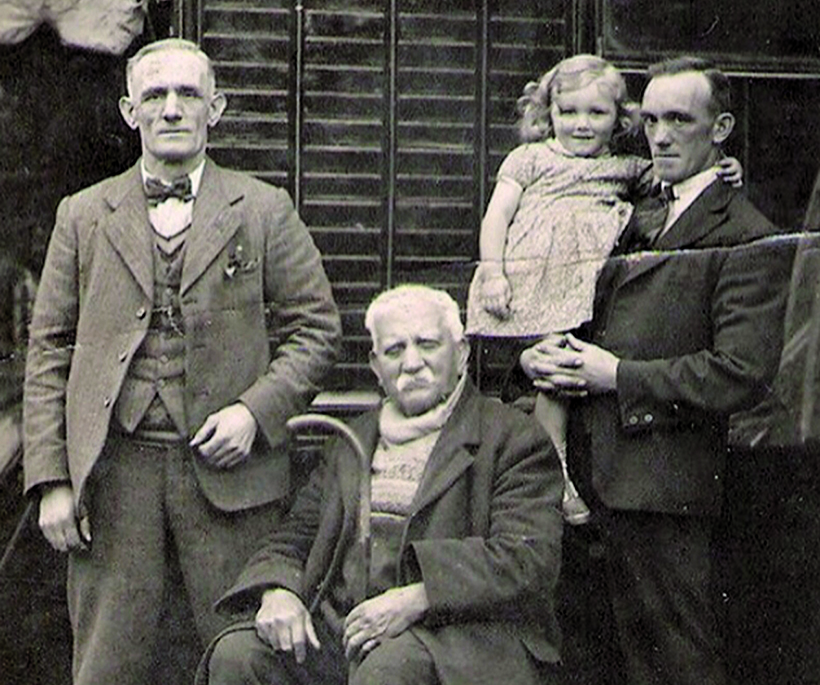
Four generations of the Sheldon family photographed around 1920. Sitting is ‘Old’ George Sheldon, then aged 83 while, on the left, is his son George. Standing on the right is George’s son, Tom, holding his daughter, Sheila.
The freshly-liveried Foden now proudly carries the lettering of ‘Est: 1820’ to denote the family lineage, but things go back much further than that. “I suppose you could trace our links to the showman’s world back five or even 600 years,” says William, “perhaps even longer. Those involved in the showman’s world have been entertaining people ever since anyone can remember.”
Have rides, will travel
Although William was named after his father (Bill), he can actually go back seven generations to the early 1800s, and a very much earlier William Sheldon. Perhaps the best-known Sheldon – in the showman’s past – is William’s great grandfather, George Sheldon: “He set up the South Wales Stall Holders & Showmen’s Protective Association, that established all manner of rules and regulations to protect the industry’s operation. And, following that – in 1889 – George was a founder-member and, in later years, the secretary, of the Showman’s Guild of Great Britain, which is still one of the industry’s mainstays today.”

Seen when fairly new, ODB 793 still has the original bumper/front tow hitch/headlight arrangement. These were changed to incorporate about two tons of ballast to prevent the front of the tractor lifting when it was under heavy load.
Over the years, the Sheldon family has moved its base around various parts of the country. Starting off in the Midlands, it first went north to Lancashire but, by the end of the 1800s, it had relocated to South Wales. Then, during the late 1940s, it was to be found in Gloucester and, today, William bases himself in Oxfordshire. As well as this locality, he also serves fairs and events across the Midlands and down into London.
One common denominator to these travelling generations of the family, has been the use of Foden as a work horse, and William still runs a stunning ’84 ‘Vision in Black’ S106 model to haul his Twister ride: “My dad ran Foden,” says William, “as did my grandfather. And my great grandfather also had a Foden steam wagon.” In fact, Foden was a marque that was used by many others: “They’ve long been a popular wagon because they were always available on the secondhand market. Spare parts for them were always in plentiful supply and, if they had a Gardner engine, then that was always first choice for many showmen to use.”

Vernon Macro is the Foden’s driver here, with a load of Watson steel en route to the construction of the M62’s Rakewood viaduct. The girders are 60ft long and weighed 25 tons each. A lot of this company’s steel was used during the M62 build, while Watson also supplied the steelwork for Blackpool’s Big Dipper ride.
Reliable and durable
Foden vehicles could also be relied upon to last longer than most, as the showman’s world has always had an odd pattern of operation. Currently, William’s season normally starts at Easter and runs until November. His vehicles are then parked over the winter months but, even during the season, they only do a modest amount of mileage as they transport the rides from one event to the next. Such an infrequency of use isn’t really liked, and William reports that it’s the electrics – especially on modern-day trucks – that tend to suffer the most.
Obviously, the 2020 season is yet to start, but William decided to make good use of the enforced stoppage: “You could actually say the restoration on the Foden was only finished because of the Coronavirus lockdown. When we knew it was coming, we got stuck in and were finally able to arrange for Graham Booth to do the signwriting just before travelling was officially curtailed.”

Fred Thompson bought the Foden in 1981, and carried out a fantastic restoration. Among the many things he did was to replace the engine with the current, 14-litre Cummins. He also gave it a stunning paint job.
That’s a slightly refreshing positive coming from these very gloomy times. Although, if truth were told, this particular slice of Foden’s history could really have ended its days when William was still an infant.
It was long a trademark with Foden that its vehicles could be built to a specific spec and, of course, when it came to the heavy haulage game, this made-to-measure philosophy was appreciated by many operators who had a variety of roles in mind for their own particular vehicles.
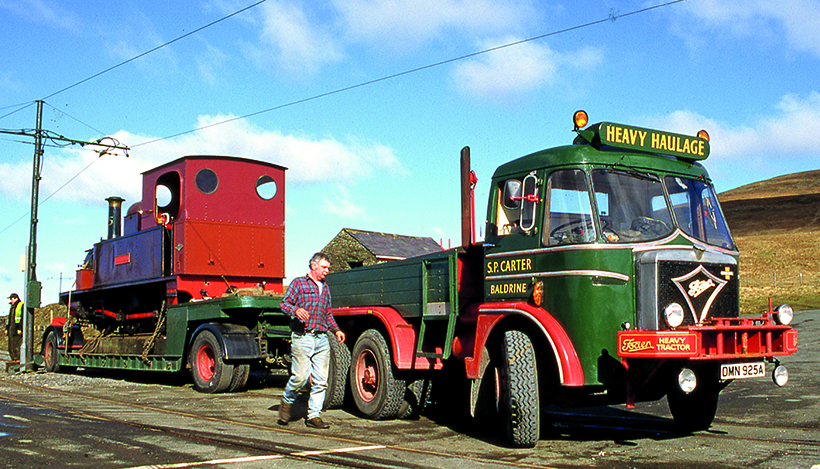
Isle of Man-based Stephen Carter bought the Foden from Fred Thompson, specifically to move locomotives like ‘Caledonia.’ Seen in early ’95, he’s just transported the locomotive up to the Bungalow – which is a famous point of the Isle’s TT course. The all-up gross weight is about 50 tons.
These ‘specials’ obviously stood out from the crowd, and most Foden devotees will tell you that ODB 793 was, of course, new to Edward Beck & Son Ltd of Greg Street in Reddish, Stockport. That’s not quite correct as archivist, George Baker, tells us that the Foden records show the 6×4 heavy-hauler was delivered on 27.2.59, direct to Contractors (Transport) Co which then registered it new on March 2nd. “It was fitted with the extended crew version of the S20-style cab,” says George, “which Foden gave the reference as the ‘6011B.’ And its wheelbase was 11ft 3.125in – to be exact.”
Beck in the mists of time
Edward Beck originally began trading in May 1945, under the Contractors (Manchester) Ltd banner but, by the late 1950s, he was also starting to livery some of his fleet with the Edward Beck & Son Ltd name. In its distinctive, bright yellow colours, the company was building quite a name for itself on the heavy haulage scene. It, too, had long put its faith in the Foden-made product, and ODB 793 was destined to be the company flagship – although, as William has since discovered, its original spec wasn’t perfect.

Here’s Stephen on the sea front at Douglas. There’s about 10 tons in this Winter Saloon carriage. Taking the weight is an American-made Rogers trailer, with a 20-ton capacity. (Pic: Bob Tuck)
Like many heavy-haulers, ODB was ordered with a winch as part of its build, but was specified to have it mounted right at the back of the chassis: “Most Fodens of this type were fitted with a Darlington winch, mounted just behind the cab – sort of mid-way down the chassis,” says William. “But, for some reason, ODB had a Foden timber-tractor-style winch mounted right on the back.”
William has correspondence from the Beck family admitting this was a mistake: “When it began hauling anything of weight,” explains William, “the Foden would lift its front axle clear of the ground.” Placing the winch at the extreme rear of the chassis was to blame for this so, to counteract that, a new front – ballasted – bumper was designed and fitted. Adding about two tons to the front end of the motor did the trick and kept the front wheels on the ground during winching operations. On the downside, though (as I discovered 35 years later), this modification made the steering a mite on the heavy side.

When William bought the Foden, it was still in the old Stephen Carter colours, although its original, UK registration plate had been affixed.
Obviously, heavy haulage drivers of old (like Beck men Teddy Martin, Vernon Macro and Robbie Brownlee) are made of strong stuff – not wimps like me – and ODB was to be involved in all manner of massive hauls on behalf of Becks. The company moved a huge amount of brand new, imported Caterpillar plant from the likes of Salford docks, and it was to be such a load that was to be the last thing ODB ever carried for its first owner. Heading down the M6, a tyre caught fire when the back axles over-heated and the rear of the vehicle became engulfed in flames. The crew was able to get out without injury, but the Foden was badly damaged and, as far as the insurance company was concerned, it was written-off as not being worth repair.
Life after Becks
However, one man’s write-off is, of course, another man’s restoration project and (back in 1995) I was told that it was to be the Macclesfield haulier, Tom Bailey, who first bought the fire-damaged remains. Then, being only eight years old, it was easy enough to get a standard – two-seater – S20 cab to go back on to the chassis.
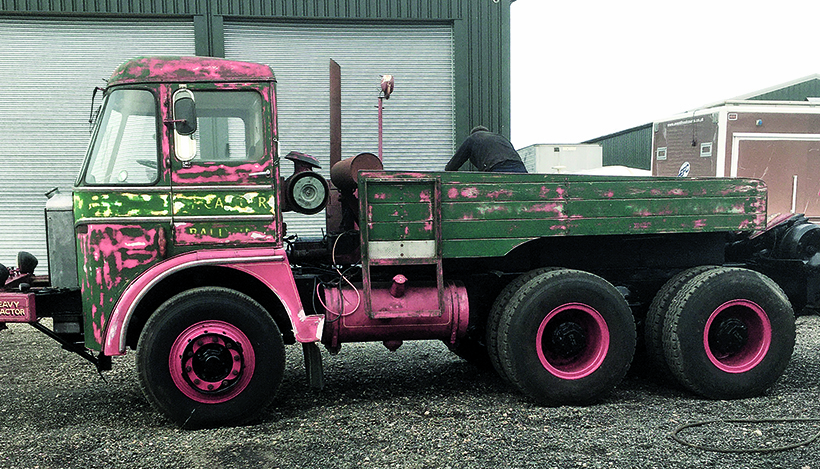
William recalls there wasn’t a huge amount of work required to restore the Foden because of the good job Fred Thompson had carried out almost 40 years earlier.
As well as repairing/replacing all the damaged remains, a large number of changes were made to the Foden’s original gearbox and back-end gearing. When built, it was rated as an 80-tonner (although Beck’s always referred to it as a 100-tonner), so its low gearing generated a very modest top speed. William now tells us it’s probably capable of 50mph, which shows you how the overall ratios were certainly changed.
In 1974, Tom apparently sold it to Staveley Lime at Buxton, where it was used to tow a mobile crusher and for recovery duties. William’s research reveals that, while at Peakstone quarry, its original Rolls-Royce engine blew up and, at that point, it was replaced with a Gardner. Then in 1981, after the vehicle had spent a period standing in the quarry, Macclesfield-based Fred Thompson enters the story, and he was to play a huge part in ensuring the Foden was to stand the test of time: “He made a cracking job of its restoration,” says William, “because, even when I started with it, I found very little was required – because of the good job Fred did with it almost 40 years ago.

William bought the Foden as a non-runner, but the only repair required to the engine was the fitting of a new water pump.
“He fitted a different, 14-litre Cummins 250 engine and, while I bought it as a non-runner, all the engine needed was a new water pump to get it going. I did consider fitting a period Gardner 8LW into the Foden – they did use this size of engine in the ‘50s, behind its large exposed style of radiator – but, because this Cummins ran so sweet, I thought it was far too good to remove.”
Fred also gave the Foden a stunning red and yellow paint job, and kept the vehicle in use on a variety of recovery work for 13 years. It was happy enough in this role, but Fred was convinced to part with it when, in October ’94, Stephen Carter came to call as he wanted it for some special Centenary traffic.

William painted the vehicle, and it’s seen here waiting for signwriter Graham Booth to work his magic. (Pic: Graham Booth)
Isle of Man
In the ‘90s, Stephen Carter was a well-known face on the Isle of Man heavy-haulage scene because he loved to use all sorts of ancient tackle to get the job done. In the past, he’d even used steam traction engines to move ‘abnormals’ and, before he bought the Foden S20, his favourite work horse was a 1948 Douglas 4×4 timber tractor. However, on the run up to the Isle, celebrating 100 years of railway activity, Stephen was approached to move a large amount of rolling stock around the island. And, to that end, the Foden 6×4 S20 was bought and given a new (rather utilitarian) SP Carter paint job.
I was able to get up close to the action in early ’95, when Stephen invited me over to the island to have a ride and drive of this classic for a feature in Truck & Drivermagazine. Even grossing 50 tons – with the steam engine ‘Caledonia’ on board – the Foden took the run up to the highest point on the island (‘The Bungalow’) in its stride. It was great to see it back working come rain, hail or shine.
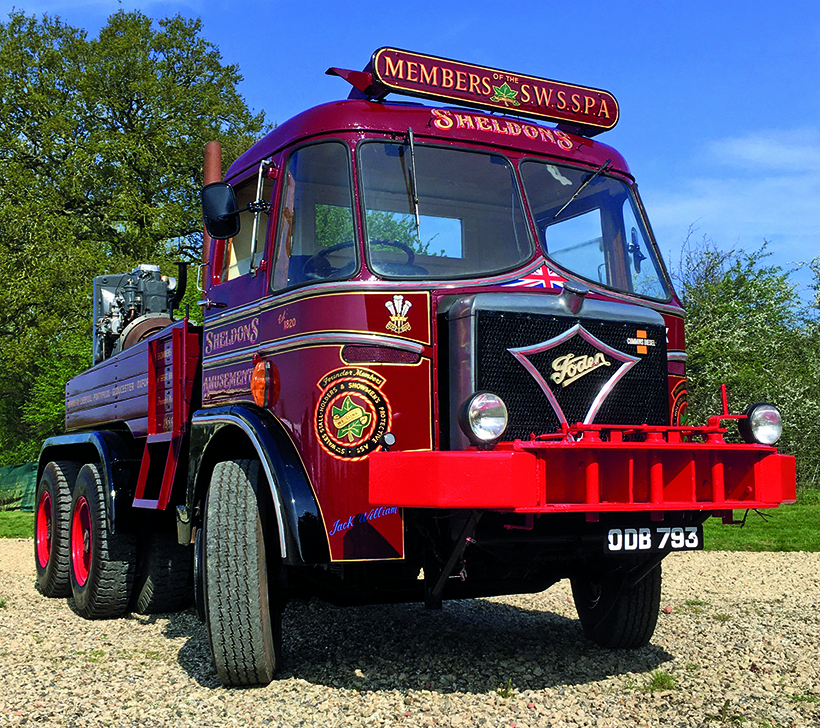
During the 1950s, Foden fitted this extra-large radiator primarily to heavy haulage vehicles which were going for export. It could also be specified for UK vehicles which were fitted with bigger engines.
I didn’t fancy driving it fully loaded but, for the drive back empty to the railway complex in Douglas, Stephen let me take the wheel, and I just loved it as the drawbar low-loader trailer followed a treat. As I said, I thought the steering was a bit heavy, but what I do recall was the huge profusion of gears which seemed available from the gearbox. The strident sound of the 14-litre Cummins was a great engine note to listen to and, I suppose, I envied Stephen being able to work such a fine slice of classic hardware.
One slight quirk about taking the Foden across the water, was the requirement to have it re-registered; it was allocated the local plate of DMN 925A. And the next time I saw this particular slice of Foden’s finest (20 years later at a holiday park near King’s Lynn), that registration plate was lying on the engine bonnet as a reminder of its time across there.
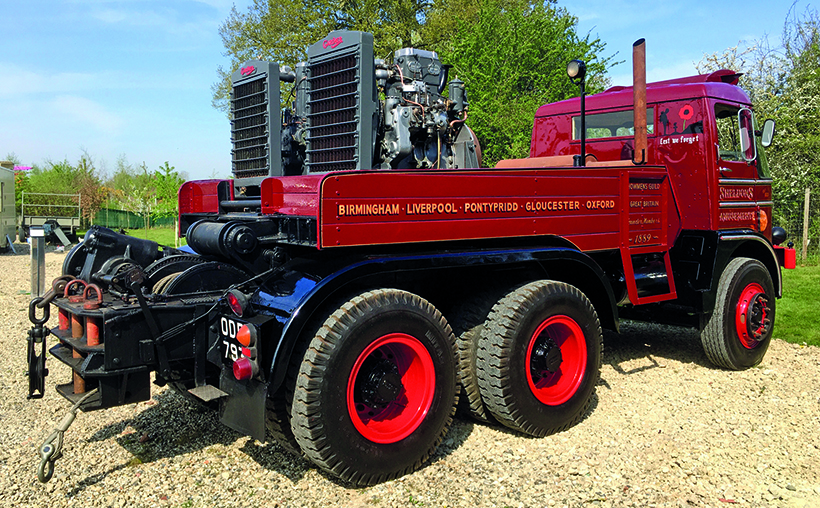
Currently, the Foden has a pair of Gardner engines mounted in the ballast box, which can provide energy for a variety of fairground rides. William is considering changing them for something else.
True destiny
It’s a personal thing whether you believe that things happen – in a certain way – because they’re meant to be. But, once you spend some time talking to William, then you’ll probably agree that he was destined to own (and then stunningly restore) this massive piece of Foden’s finest.
After Stephen Carter had finished all the railway work he had for the Foden, he put it up for sale. William reckons that it actually passed through the hands of two or three other people on the island before it came back on the ferry once bought by Manchester-based Chris Bennett. Chris obviously had plans to restore the vehicle to its original glory but, when those fell through, it was again put up for sale: “I actually tried to buy it from Chris,” says William, “but, for some reason, we couldn’t get together and he moved it on to someone else.”
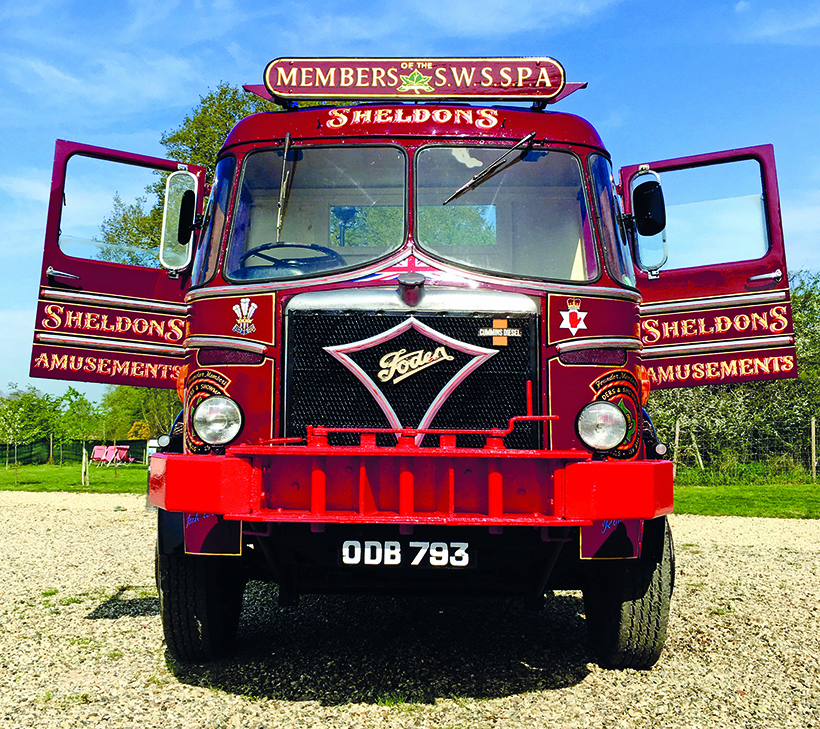
All manner of details have been incorporated into the vehicle’s signwriting.
It may be hard to believe, but this nearly/almost bought it scenario cropped up again and again, as William just missed buying it on several occasions over the following 15 years or so. Although, as we all know now, he eventually took over its ownership in 2017, from someone in Cambridgeshire. “Actually, I then just stood it in the garage for a while until we had some time to do it – and as I said, if it wasn’t for the virus, then I may not have got it finished so quickly. Although, as I also said, the restoration was very straightforward because Fred Thompson made such a good job of it almost 40 years earlier.”
What a stunner!
This isn’t William’s first restoration project. He cut his teeth on a 1952 Scammell ballast box tractor about 20 years. “Actually, that could now do with another restoration, but I also have a 6×4 Atkinson Venturer which is ex-Pickfords, and fitted with an eight-cylinder Gardner.”
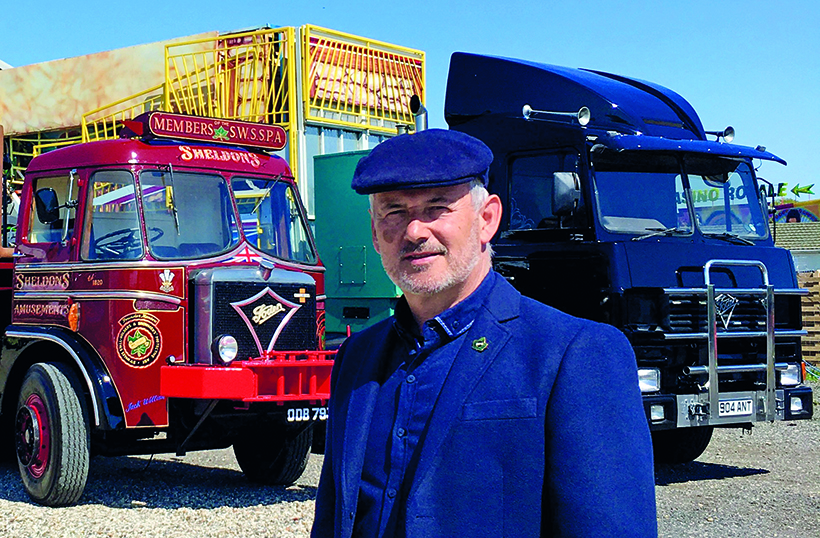
William Sheldon is a long-standing fan of the Foden marque.
The showman’s life is all William has ever known – or ever wanted – but his ability to look after all manner of equipment (of all manner of vintages) has been picked-up by working closely with his father, Billy, while a youngster: “I can recall, when I was about 12, how I helped him rebuild a wagon engine while we were at a fair.” Having such expertise meant he was able to do the Foden’s restoration all by himself. “As I said, there wasn’t a huge amount to worry about. I told you about the water pump and I also had to rebuild the foot brake valve. But I tried to keep as much of the original vehicle as possible intact. That included retaining a stretch of timber from the body that had been damaged, but was just repaired as best I could. It’s great how the vehicle still has the original ballast block weights which Foden fitted in 1958, when it was under build.”
Graham Booth took on the job of applying the final signwriting, and William recalls using his memories of various showman vehicles of old for the incorporation of all manner of various personal touches. We just love all the detail. Perhaps the biggest bit of detail William has added is the brace of Gardner engine generator sets, which he’s mounted inside the ballast box – these are great. “I’ve had those for years,” he says. “One is a two-cylinder Gardner 2LW, while the other is a 1L2 one-cylinder unit. I was going to use them to generate power for some kiddies’ rides perhaps. Although I was thinking of taking them off and putting something else on in their place – I’m not quite sure.”
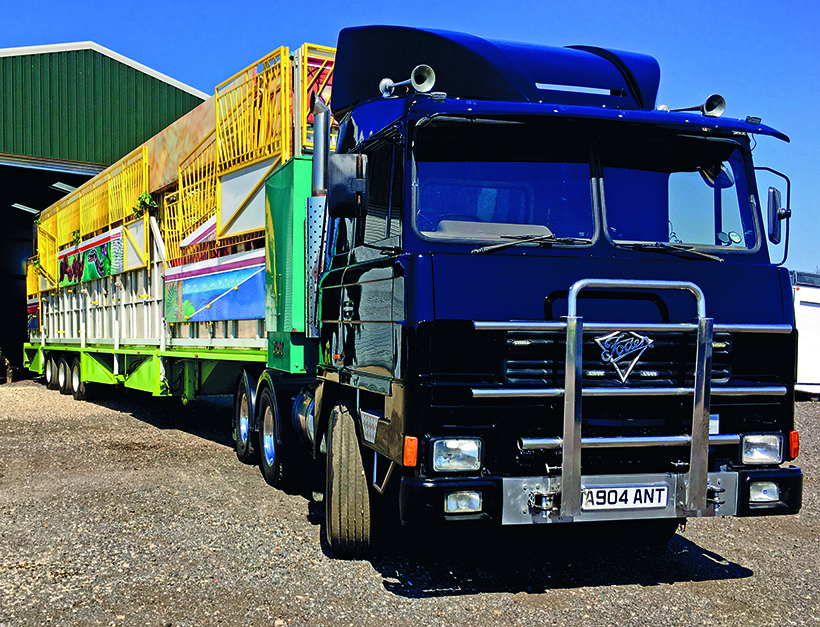
William currently uses this Foden S106 to haul his Twister fairground ride.
That thought might strike you as a shame as the finished article looks absolutely stunning to the eye. However, it just emphasises the point that William has restored the Foden to put it back to work – not just to look at and admire. Doing this means he’s just following in the path of the various owners who have made use of the Foden over the past 61 years: “It’s been owned by all sorts of people,” he tells us. “True, some of those didn’t do anything much with it, but those that had it on the road, always used it to work. It was never looked upon as a toy and I just wanted to keep that working use going.”
Photographs: William Sheldon/as stated
For a money-saving subscription to Heritage Commercials magazine, simply click here



